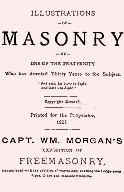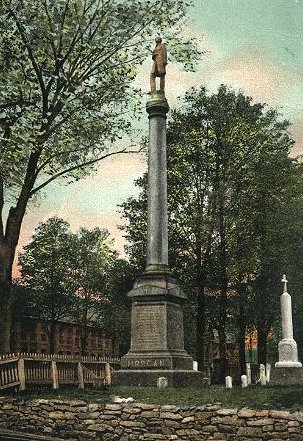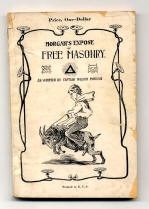
The Masonic Murder!
Much has been made of the death of an anti-Mason, 'Captain' William Morgan - and many of those who are anxious about Freemasonry hear of some heinous murder that the Masons committed. It's really not quite that simple as you'll soon see.
 William Morgan was born in 1774 (yes,
over 235 years ago!) in
Virginia. In 1819 at age 45 he was married to a girl sixteen years of age.
Two years
later he moved to Canada and became a distiller. Fire destroyed his brewery and
reduced him to poverty after which he moved again. In 1823, he was at
Rochester, New York and subsequently took up residence in Batavia, New York in 1826. While he had
visited lodges before this time, there is no evidence to show where (or if) he was
initiated, despite his rather complete knowledge of the ritual. He was denied admission to the local Lodge and Chapter (of York Rite Masonry)
at Batavia for reasons unknown. (Refusal to admit a Mason to a lodge meeting is
quite rare but does happen when a visitor's status as a Mason is in question.) However, it is confirmed
that he received the York Rite Royal Arch Degree at LeRoy, New York in 1825. When a new
Chapter was proposed in his own town, his name was on the petition but objection was made
to his being included and a new petition was prepared without it. Resenting this action, Morgan apparently became
bitter and sought revenge. He entered into a conspiracy with the local newspaper editor to
publish a malicious book on Freemasonry.
William Morgan was born in 1774 (yes,
over 235 years ago!) in
Virginia. In 1819 at age 45 he was married to a girl sixteen years of age.
Two years
later he moved to Canada and became a distiller. Fire destroyed his brewery and
reduced him to poverty after which he moved again. In 1823, he was at
Rochester, New York and subsequently took up residence in Batavia, New York in 1826. While he had
visited lodges before this time, there is no evidence to show where (or if) he was
initiated, despite his rather complete knowledge of the ritual. He was denied admission to the local Lodge and Chapter (of York Rite Masonry)
at Batavia for reasons unknown. (Refusal to admit a Mason to a lodge meeting is
quite rare but does happen when a visitor's status as a Mason is in question.) However, it is confirmed
that he received the York Rite Royal Arch Degree at LeRoy, New York in 1825. When a new
Chapter was proposed in his own town, his name was on the petition but objection was made
to his being included and a new petition was prepared without it. Resenting this action, Morgan apparently became
bitter and sought revenge. He entered into a conspiracy with the local newspaper editor to
publish a malicious book on Freemasonry.
(Some reports indicate that David C. Miller, the newspaper editor, had received the Entered Apprentice - first - degree in Freemasonry but objections arose and he was prevented from proceeding further. This, some Masonic scholars assert, could have given rise to his interest in taking part in the scheme of Morgan's....)
There was great resentment in the town and the newspaper building was set on fire but no serious damage was done. As a result of this hotheadedness, four Freemasons were indicted and three were sent to jail. In fact, the Masons themselves offered a reward for the guilty party and some assert that Miller set the fire himself. There is, however, no proof as to what actually happened.
 Morgan was arrested several times on
various claims, some real and some apparently 'trumped up', possibly at the
instigation of the local Masons. In one of these instances, a
man came to pay the bail for Morgan and from that day on, Morgan was supposedly never seen
again. Some 'eye-witness' reports tell of him being taken away by a group of men
carrying torches. Other 'eye-witness' reports indicate that he was given a horse
and wagon and rode away alone. There were at least a half-dozen 'eye-witness'
reports, all of which were at odds with the other.
Morgan was arrested several times on
various claims, some real and some apparently 'trumped up', possibly at the
instigation of the local Masons. In one of these instances, a
man came to pay the bail for Morgan and from that day on, Morgan was supposedly never seen
again. Some 'eye-witness' reports tell of him being taken away by a group of men
carrying torches. Other 'eye-witness' reports indicate that he was given a horse
and wagon and rode away alone. There were at least a half-dozen 'eye-witness'
reports, all of which were at odds with the other.
Since then, various explanations have been put forth over the years, the most common being that Morgan was murdered by Masons.
A month after Morgan left the jail, a badly decomposed body was found some distance away. The now-widow of Morgan first said it was not her husband and was quite emphatic in so doing, citing total difference in body height, facial hair, etc. Later, she changed her story. Reports are that the corpse changed appearance several times as well leading to charges and counter-charges of skullduggery!
A Mrs. Monroe claimed that it was the remains of her husband and those remains were turned over to her after an inquest. The foes of Masonry did not believe it then and they don't believe it now. There were subsequent stories of seeing Morgan in other lands but despite the interest of thousands of scholars and some 39 different official investigations, the mystery is just as obscure now as it was then. The Governor of New York, a Mason himself, offered a reward of $2,000 (an enormous sum at that time) for the identification of the murderer(s) and yet - despite SO many making claims that they 'knew' who did this heinous crime, no one ever claimed that reward.
| With a solid victory over the Britain and enormous changes
taking place in the new country, Americans at this time faced a "villain vacuum"
similar to our early-'90s directionlessness in the wake of the Cold War.
Those in upper state New York in particular had been the 'subjects' of
frequent and persistent visits by traveling
preachers railing about the Hell-fires of damnation which would surely
consume them - hence the reference to the 'Burnt-over District'. These
people, along with many others in the Northeast of the relatively new
United States sought a
new 'bad guy' on whom to blame their troubles. Secret societies, it was believed, were a
very real threat to the fragile new republic, and Freemasons because of their secrecy became public
enemy number one. Their fervor was heightened by publication of works about the Illuminati
which ostensibly sought world control. It was a difficult time for people facing
difficult hardships of daily living and potential economic ruin due to
rampant inflation. The 'targets' of their anger could be spotted easily: they were the leaders of the community and of business. They were the influential in all walks of life. They met together in mostly well-appointed buildings wearing clothes many others could only covet. There is little question, then, why they would be the object of such jealousy - and having William Morgan's disappearance as a rallying point, it became a wonderful 'popular cause' around which politicians could gain support. |
While Freemasonry promptly disavowed any sympathy with those who might have decided to punish Morgan for his supposed wrongdoing, it did little to check the resentment which grew and festered in this poor area where unemployment ran extraordinarily high and people were willing to believe anything that might explain their misfortunes.
It's highly unlikely we'll ever know what really happened to William Morgan. 170+ years separate us from those involved and yet despite the furor which led to the formation of the Anti-Masonic (political) Party in the United States, even Morgan's contemporaries were unable to solve the crime.
It remains today a 'Masonic Mystery'.
Despite the horrific and oft-made claims bandied about by the foes of Freemasonry, they don't know any more about this than the rest of us. There has never again been a similar incident anywhere in the world.
![]()
Follow-up with recent works about The Morgan Affair
| Stephen Dafoe is known
to many as a result of hosting a website relating to the Knights Templar as
well as one that featured a vigorous discussion forum on the topic
of Freemasonry, focusing in particular on anti-Masonry. He is the
author of several Masonic books and Morgan: The Scandal That
Shook Freemasonry has been much anticipated. Filled with
original documents and period sketches, it is truly a reference work worth owning. A goodly
portion of the book consists of previously difficult to locate documentary material which allows
the scholar to examine source material for themselves. While Dafoe has approached Morgan as a detective, Robert Berry's The Bright Mason is more traditional and explores the subject as a narrative. It is well documented and tells the Morgan story from a somewhat different angle. Again, well worth the reading! Together, these two books will advance your understanding of this tumultuous event considerably and we'd encourage you to read both! |
Some additional Thoughts and information
The life and death of Morgan has many twists and turns. Here are some things that are relevant:
Morgan's Widow and Joseph Smith (Mormon)
To add further intrigue, it was later alleged that Morgan's widow became one of the wives of Joseph Smith who was then forming his Mormon Church. This connection gives anti-Masons with religious objections to both Freemasonry and Mormonism some type of 'hook' on which to hang their harangues. Of course, they ignore the facts that Morgan was against Masonry and his wife then chose to be with someone who would become a Mason.... Confusing, isn't it?
Other Hatreds and Conspiracies
It is important to remember that the strong sentiments which gave rise to the Anti-Masonic party were not limited to hatred of Masonry alone. In 1834, for example, an anti-Catholic mob set fire to a convent in Charlestown (now Somerville), Massachusetts. The book Fire and Roses is well worth reading to understand the intense and usually irrational feelings that many had.
The following
year, Samuel F. B. Morse (better remembered as a portrait painter and inventor of the
telegraph) published his
Foreign Conspiracy against the Liberties of the United States
which became something of a textbook
for those crusading against what they thought was a Popish plot to gain control of the
United States.
Now it is not our intent to cast the "Morgan Affair" as a 'conspiracy' by anti-Masons to defame Freemasonry. It simply was not! The early 1800s in the newly created United States were rife with conspiracy theories. The Illuminati - although by then only an imaginary organization - was seen by many as being the secret controller of the world. At a time when allegiances and alliances swayed by the whims of individual rulers and the United States still had yet to sort out what type of 'democracy' they had really invented, such theories were powerful indeed. Thoughts of hidden conspirators fueled by soaring inflation and lack of employment in places like Batavia, gave rise to many feelings of inadequacy. People sought consolation in the conspiracy theories of the day, regularly trumpeted from the pulpits of evangelists who were losing their 'flocks' to an increasingly more mobile society. While some of those who believed such wild theories were surely honest and forthright, others saw intrusions from each and every outside force even if there were none.
The defining example of these conspiracy theories rampant at the time is, to
us, the convent burning and the killing of innocent Catholic nuns mentioned
above - eight years AFTER Morgan's disappearance - all because some few
residents there thought the Pope was going to take over their country. The
Morgan Affair reflects few differences. The fear of the Freemasons and
Illuminati was palpable. The presumed murder of an individual was the final
proof of all for some that Freemasonry was without law and would ultimately
control them.
If Masons killed Morgan, they should have been punished. No Mason is above the law and the SECOND duty that a Mason has is to his country and its laws (the first, to God) so clearly an act of murder is neither condoned nor pardonable. Dozens of inquiries and inquests and hundreds of scholarly inquiries since that time, however, have failed to produce proof that any such act really did occur.
Today, anti-Masons like to use the example of Morgan to show the evils of Freemasonry while ignoring both the millions of men who've been members during the intervening nearly 200 years and the fact that such an event has never again reoccurred in the history of the organization. That statement is not - by any means - an attempt to say, "So what? It's only one...." Rather, we are of the belief that IF Masons murdered Morgan they should have been swiftly punished for their crimes and if they did not, the anti-Masonic faction should drop their use of this tired canard immediately. We repeat: there is no proof that Morgan was ever murdered.
![]()
March, 2003: The Grand Lodge of Masons in Vermont is placing online a text which recounts much of the 'Morgan hysteria' that effected Masonry there far more than elsewhere. You can read it by clicking here.
![]()
Can it happen again?
To Masons, perhaps the most absurd suggestion is that if this type of murder could happen once then it certainly could occur a second time. In fact, there is some vague truth in such a thing. We assume that nobody could be so darn stupid today as to think that they were somehow protecting Freemasonry but who knows? Some rogue individual could do something untoward. They would, of course, be immediately disowned by the Masonic fraternity because one obligation every Mason takes is to obey the moral law - and that, obviously, includes the admonition "Thou shalt not kill."
So, in theory, you MIGHT be able to suggest that this or that event was somehow similar to Morgan's disappearance but the suggestion alone does not prove the link between the two. And, absent even a shred of proof that Freemasonry was somehow involved, it is all conjecture - something conspiracy theorists consider fact.
![]()
Updated 1 January 2010
|
Related Topics: |
|
In addition, |